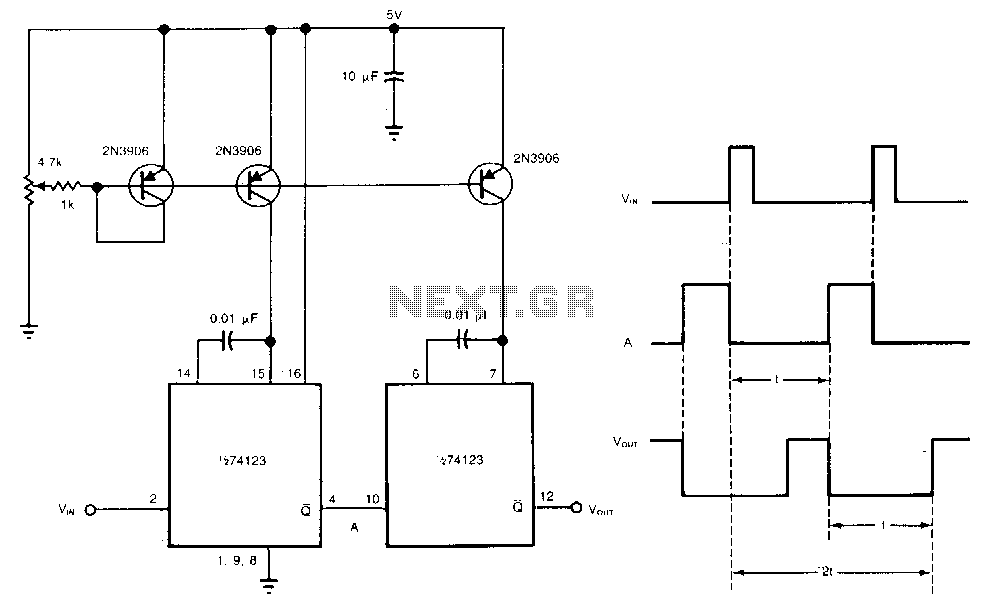
Adjustable-delay

It is possible to achieve over 360° of phase delay by cascading two monostable multivibrators. In a typical configuration, a single monostable multivibrator introduces a delay in a pulse train by triggering on each incoming pulse, provided it resets in time for the next pulse. However, a single monostable multivibrator can only provide a maximum phase delay of less than 360°. By utilizing a cascaded multivibrator approach, a phase delay of up to 650° can be attained, using an input pulse spacing of 200 microseconds, along with specific component values. Each input pulse triggers the circuit while allowing for adjustments in the phase delay throughout its range.
The first multivibrator triggers the second, with the reset of the second marking the total delay time. Each multivibrator introduces a delay of t microseconds, which is determined by 0.01 microfarad timing capacitors and equal charging currents sourced from a three-transistor, dual-current source configuration. The arrangement of the two multivibrators ensures that the first multivibrator resets in time to be triggered by the subsequent input pulse. Additionally, the variation of the delay time t is linear with respect to the setting of the potentiometer.
The circuit consists of two monostable multivibrators connected in series, where the output of the first multivibrator serves as the trigger input for the second multivibrator. The design employs timing capacitors rated at 0.01 microfarads, which are critical for establishing the timing intervals. The three-transistor dual-current source is configured to provide equal charging currents to both capacitors, ensuring that the timing characteristics are consistent and reliable.
In practical applications, this cascaded configuration is particularly useful in digital signal processing and timing applications where precise control over phase relationships is necessary. By adjusting the potentiometer, the user can finely tune the delay introduced by the circuit, allowing for versatile applications in synchronous systems, clock generation, and signal conditioning. The ability to achieve a phase delay exceeding 360° opens up further possibilities for complex timing adjustments in electronic systems.You can obtain well over 360° of phase delay by cascading two monostable multivibrators. In a typical configuration, a single monostable multivibrator is used to introduce delay in a pulse train; the multivibrator triggers on each incoming pulse, provided it resets in time for the next pulse. Yet even when it resets in time, the single monostable multivibrator provides a maximum phase delay of less than 360°.
However, with the cascaded-multivibrator approach, you can achieve 650° of phase delay by using an input-pulse spacing of 200 p.s for example, with the component values shown. Every input pulse will trigger the circuit while you adjust the phase delay throughout its available range.
The first multivibrator triggers the second one, whose reset marks the total delay time (21). Each introduces a delay oft p.s, based on 0.01-p.F timing capacitors and equal charging currents from the three-transistor, dual-current source. The two multivibrator arrangement allows the first multivibrator to reset in time to be triggered by the next input pulse.
Also, the variation of t is linear with the potentiometer setting. 🔗 External reference
The first multivibrator triggers the second, with the reset of the second marking the total delay time. Each multivibrator introduces a delay of t microseconds, which is determined by 0.01 microfarad timing capacitors and equal charging currents sourced from a three-transistor, dual-current source configuration. The arrangement of the two multivibrators ensures that the first multivibrator resets in time to be triggered by the subsequent input pulse. Additionally, the variation of the delay time t is linear with respect to the setting of the potentiometer.
The circuit consists of two monostable multivibrators connected in series, where the output of the first multivibrator serves as the trigger input for the second multivibrator. The design employs timing capacitors rated at 0.01 microfarads, which are critical for establishing the timing intervals. The three-transistor dual-current source is configured to provide equal charging currents to both capacitors, ensuring that the timing characteristics are consistent and reliable.
In practical applications, this cascaded configuration is particularly useful in digital signal processing and timing applications where precise control over phase relationships is necessary. By adjusting the potentiometer, the user can finely tune the delay introduced by the circuit, allowing for versatile applications in synchronous systems, clock generation, and signal conditioning. The ability to achieve a phase delay exceeding 360° opens up further possibilities for complex timing adjustments in electronic systems.You can obtain well over 360° of phase delay by cascading two monostable multivibrators. In a typical configuration, a single monostable multivibrator is used to introduce delay in a pulse train; the multivibrator triggers on each incoming pulse, provided it resets in time for the next pulse. Yet even when it resets in time, the single monostable multivibrator provides a maximum phase delay of less than 360°.
However, with the cascaded-multivibrator approach, you can achieve 650° of phase delay by using an input-pulse spacing of 200 p.s for example, with the component values shown. Every input pulse will trigger the circuit while you adjust the phase delay throughout its available range.
The first multivibrator triggers the second one, whose reset marks the total delay time (21). Each introduces a delay oft p.s, based on 0.01-p.F timing capacitors and equal charging currents from the three-transistor, dual-current source. The two multivibrator arrangement allows the first multivibrator to reset in time to be triggered by the next input pulse.
Also, the variation of t is linear with the potentiometer setting. 🔗 External reference